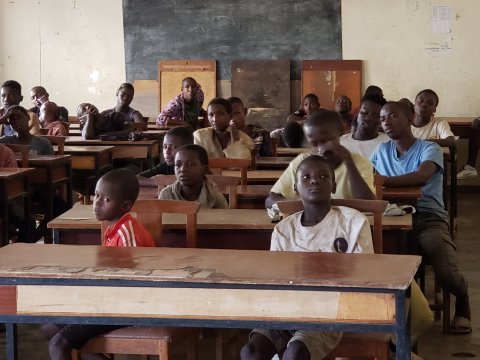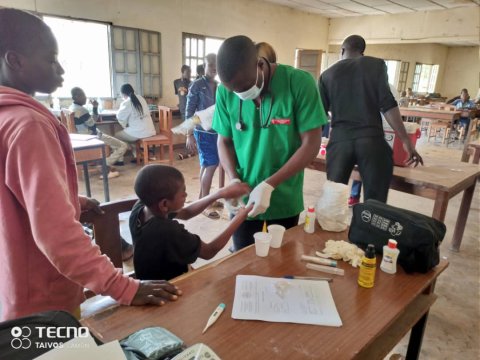Malaria, helminths, and other health challenges among street children and youths in Cameroon

Valerie Makoge, Early Career Grant 2021 awardee and RSTMH Global Assessor, recently published an article in International Health titled ‘Unveiling the hidden health challenges: malaria, helminths, STIs and other pathologies among street children, adolescents and young adults in Cameroon’. In this blog, she summarises the key findings.
In the bustling urban centres of Cameroon, particularly in the capital Yaoundé, the day’s routine often masks a profound public health challenge. Among the city’s many residents are children, adolescents, and young adults who live on the streets – individuals whose precarious conditions expose them to a multiplicity of health risks. This blog examines recent findings on the prevalence of infectious and other diseases among these street children, adolescents and young adults (SCAYA) and discusses the implications for targeted public health interventions.
The context of street children, adolescents and young adults in Cameroon
Globally, the phenomenon of street children has drawn increasing attention. A UNICEF estimate highlighted that approximately 150 million children worldwide live on the streets, due to conditions of poverty, family instability, and abuse. Africa hosts more than 10 million children due to similar challenges. Despite the adoption of international frameworks such as the United Nations Convention on the Rights of the Child, these vulnerable young people remain largely marginalized – especially in developing countries like Cameroon, where public and private healthcare systems are hardly accessible to them.
In major cities such as Yaoundé, street children and youths are a visible yet mostly underserved population. They spend nights in open spaces – markets, bus terminals, train stations – and are often forced to work in informal economies to secure a meagre income or beg for their daily bread. It is in this setting that a recently published cross-sectional study, sought to evaluate the health status of SCAYAs through direct medical consultations, and laboratory analyses of blood and stool samples.
Study overview and methodology
The study was part of a broader mixed-method research entitled “Investigating Malaria, Other Health Challenges, Coping Strategies, and Opportunities for a Coordinated Response for Street Children in Cameroon.” Conducted in Yaoundé, the study involved 147 male street-children and youths, recruited from the six health districts of Yaoundé with the collaboration of the Regional Delegation of Social affairs, the Yaoundé Listening and Transit Centre (CETY) and community organization of former street children known as OCALUCOPER.
Medical assessments performed by qualified clinicians included physical examinations – focusing on general health, mental well-being, and risky behaviours. Blood samples were collected to screen for malaria, anaemia, HIV, and hepatitis B; stool samples were collected to screen for helminth infections. This comprehensive approach was intended to provide insight into both the prevalence and the intensity of various health challenges within this underserved population.
Key findings: the burden of disease
The results of the study indicate a significant health burden among SCAYAs. Nearly all participants reported sleeping in unsheltered locations, increasing their exposure to disease vectors such as mosquitoes. This exposure was associated with a malaria parasitaemia prevalence of 34.3% – a figure notably higher than the national average. The predominant species identified was Plasmodium falciparum, with additional cases of Plasmodium malariae and rare instances of Plasmodium ovale. These findings underscore the role of asymptomatic carriers in sustaining malaria transmission and highlight challenges for elimination/eradication efforts.
Screening for sexually transmitted infections revealed an HIV prevalence of 3.6% and hepatitis B prevalence of 8.7%, statistics that reflect the heightened vulnerability of SCAYA due to factors such as sexual exploitation and limited access to preventive health services. Additionally, stool sample analysis indicated a 10.9% prevalence of geo-helminth infections – with Schistosoma mansoni representing the majority of these cases. Gastrointestinal parasitic infections, in combination with other conditions such as respiratory ailments and skin infections (including scabies and ringworms), paint a picture of a population facing multiple, overlapping health challenges.
The clinical assessments also uncovered common non-infectious conditions. Poor oral hygiene, untreated wounds, musculoskeletal injuries from street violence or accidents, and even signs of mental and emotional distress were frequently noted. Although many participants demonstrated a basic awareness of their health, limited financial resources and lack of access to medical care facilities further exacerbated their conditions.
Implications for public health policy and practice

The findings of this study are of significant public health importance. They document the high prevalence of infectious diseases among a population that is often ignored by conventional healthcare systems. The considerable rate of asymptomatic malaria among SCAYA, for example, positions them as a potential reservoir for disease transmission in regions where malaria remains endemic. Addressing such conditions requires innovative, context-specific strategies.
One of the primary recommendations emerging from this work is the need for mobile healthcare units that can reach SCAYA in their own environments. Such services could provide regular medical check-ups, vaccinations, and health education, reducing the reliance on static clinics that fail to serve transient populations. Equally important are initiatives aimed at improving living conditions – ranging from the creation of safe shelters and group homes to rehabilitative programs that facilitate family reunification or socially integrated housing.
Strong partnerships between government agencies, non-governmental organizations, and community groups are essential for the success of these initiatives. In this study, collaboration with the Ministry of Social Affairs and OCALUCOPER proved crucial in accessing and caring for street-connected youth. These alliances not only help deliver immediate health services but also offer a platform for long-term solutions that address the root causes of the phenomenon of street children.
The path forward
While this study had primarily male participants – a reflection of the challenges of recruiting female SCAYA – the insights it provides are valuable for broadening our understanding of how urban poverty and marginalization contribute to health disparities. Future research should aim to further elucidate the experiences of female street-connected youth and extend investigations into areas such as nutritional status and mental health, which remain underexplored.
Ultimately, the evidence calls for a coordinated, multi-sectoral response to the health inequities facing street children and youths in Cameroon. By targeting both immediate health needs and the broader social determinants of health, policymakers and practitioners can begin to mitigate a crisis that not only impacts individual lives but also public health at large.
Conclusion
The health challenges documented among Cameroon’s street children and youths reveal a harsh reality of overlapping infectious diseases, physical ailments, and social neglect. These findings serve as a call to action for more comprehensive and innovative public health strategies—strategies that must extend beyond conventional medical interventions to encompass improvements in housing, education, and social support. Addressing the health needs of this vulnerable population is a moral and public health imperative, and it is hoped that these insights will catalyze meaningful policy reforms and resource allocations in the future.